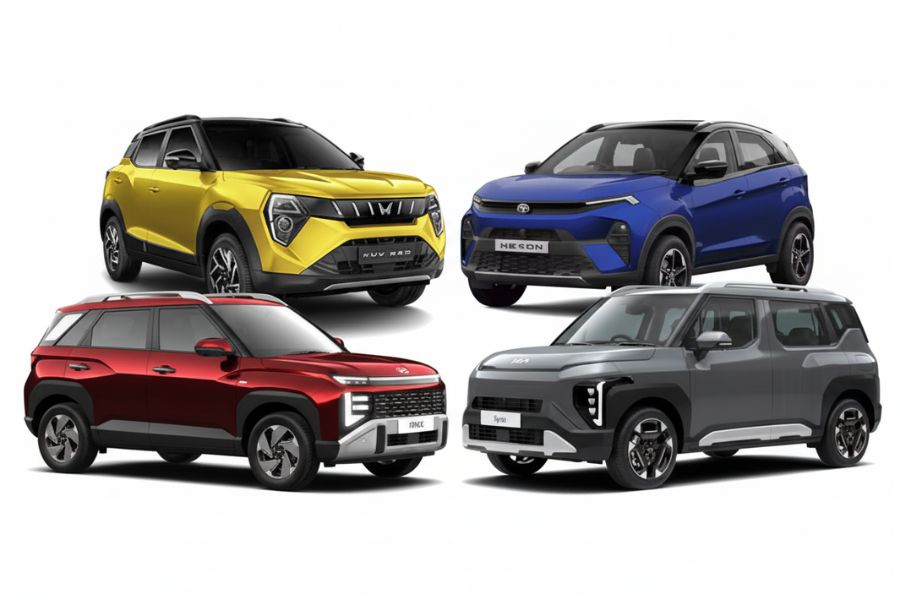Tata Motors has taken a bold step forward with the launch of the Harrier EV, its most powerful and technologically advanced electric SUV yet. While it shares its design DNA with the diesel-powered Harrier, the EV version is a completely different beast under the skin. From powertrains to tech features, here’s a detailed comparison between the Tata Harrier EV and Harrier Diesel.
1. Design and Dimensions: Familiar but Futuristic
Harrier EV: Subtle but Effective Styling Tweaks
The Harrier EV retains the muscular stance of the diesel version but incorporates EV-specific elements such as a closed grille, redesigned front bumper, silver skid plates, EV badging, and aero-optimized alloy wheels. These enhancements contribute to both visual identity and aerodynamic efficiency.
Harrier Diesel: More Colour Choices
In terms of paint options, the diesel Harrier wins with eight colour choices, including Coral Red, Ash Grey, and Seaweed Green. The EV, meanwhile, offers five distinct shades, including Nainital Nocturne and Empowered Oxide, with a more premium, futuristic appeal.
Dimensions Comparison:
-
Harrier EV: 2mm longer and 22mm taller
-
Wheelbase: Identical at 2,741mm
2. Interior & Cabin Features: Digital Edge for EV
Shared Layout with Premium Upgrades in EV
Both SUVs share a near-identical cabin layout with features like a four-spoke steering wheel with an illuminated Tata logo, touch-based HVAC controls, and premium finishes. However, the Harrier EV gets a larger 14.53-inch Samsung Neo QLED touchscreen, claimed to be a world-first.
EV’s Smart Mirror and Storage Additions
The EV also stands out with an all-digital IRVM featuring dual-camera dashcam integration and continuous front/rear recording. It also offers more boot space (502L) and includes a frunk (front trunk), while the diesel version provides 445L of cargo capacity.
3. Features and Safety Tech: EV Goes All-In
New TiDAL Electrical Architecture in EV
The Harrier EV is built on the all-new TiDAL platform (Tata Intelligent Digital Architecture Layer), unlocking cutting-edge features such as:
-
540-degree surround view
-
Level 2 ADAS
-
Voice assistant
-
OTA (Over-The-Air) updates
-
Auto park assist and summon mode
-
Off-road assist with crawl functionality
DrivePay and Connectivity Innovations
A standout EV-exclusive is DrivePay, a UPI-based in-car payment system that removes the need for smartphones at tolls, EV chargers, and drive-thrus. Other additions include Vehicle-to-Load (V2L) and Vehicle-to-Vehicle (V2V) charging support.
Common Features in Both Models:
-
Ventilated, powered front seats with memory function
-
Dual-zone climate control
-
Powered tailgate
-
Wireless charger, fast-charging USB-C ports
-
Panoramic sunroof and ambient lighting
-
Rear window sunshades
-
Cooled central storage with sliding armrest
The EV also introduces Boss Mode, allowing the front passenger seat to auto-adjust for added rear-seat legroom.
4. Powertrain & Performance: Diesel vs Dual-Motor EV
Harrier Diesel: Tried and Tested Turbo-Diesel
Powered by a 2.0-litre 4-cylinder turbo-diesel, the Harrier delivers 170hp and 350Nm, paired to either a 6-speed manual or a 6-speed automatic. Performance is decent with a 0-100kmph time of 11–12 seconds.
Harrier EV: Powerful, AWD Capability
The Harrier EV is built on the updated Acti.ev platform, a heavily reworked version of the Omega architecture. It comes with two battery options:
-
65kWh RWD (238hp)
-
75kWh AWD (313hp, 504Nm)
The AWD version can sprint from 0-100kmph in just 6.3 seconds, thanks to Boost mode, one of four driving modes: Eco, City, Sport, and Boost (AWD only).
Advanced Off-Road Features in EV:
-
Multi-link rear suspension
-
6 terrain modes (vs 3 on diesel): Normal, Grass/Snow, Mud/Ruts, Sand, Rock Crawl, and Custom
-
Transparent underbody camera view
-
Four levels of regen braking
-
Drift mode (EV only)
5. Range & Charging: Long-Distance Ready
Harrier EV Range Estimates:
-
627km (RWD, MIDC)
-
622km (AWD, MIDC)
-
65kWh version range – to be revealed
Charging Times:
-
7.2kW AC charger: Full charge in 10.7 hours
-
120kW DC fast charger: 20–80% in 25 minutes, or 250km in 15 minutes
6. Pricing and Variants
Harrier Diesel: Broad Line-Up
The diesel variant is available in 16 trims, from Smart to Fearless+ Stealth, priced between Rs 15 lakh and Rs 26.50 lakh (ex-showroom).
Harrier EV: Limited Launch Line-Up
The EV is currently offered in three variants: Adventure, Fearless, and Empowered.
-
Starting price: Rs 21.49 lakh (introductory, Adventure trim)
-
Top-end pricing yet to be revealed
-
Lifetime battery warranty included
Verdict: Harrier Diesel vs Harrier EV – Which One to Choose?
If you’re looking for tried-and-tested mechanicals, wide variant options, and a lower entry price, the Harrier diesel remains a solid choice. However, if you want cutting-edge tech, faster acceleration, all-wheel-drive capabilities, and eco-friendly credentials, the Harrier EV is the future-ready option — especially with its impressive range, innovative features, and next-gen connectivity.
Read More:




